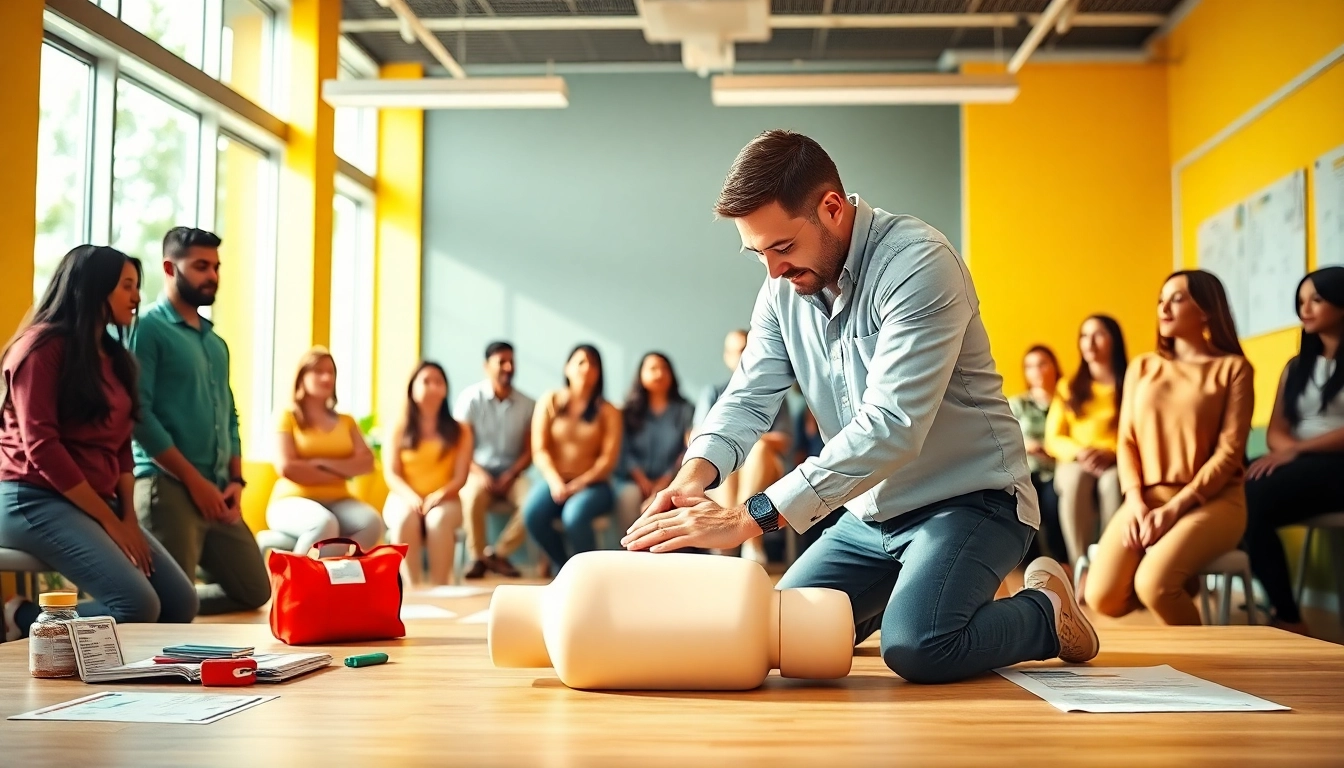Understanding First Aid Certification
What is First Aid Certification?
First aid certification is an acknowledgment that an individual has successfully completed a program designed to teach essential life-saving skills and procedures in medical emergencies. This certification is often acquired through accredited organizations and institutions, ensuring that the training aligns with regulatory standards and best practices. The content of these programs might include topics such as CPR (Cardiopulmonary Resuscitation), wound care, splinting fractures, and recognizing the signs of various medical conditions. The skills learned through first aid certification courses are crucial for anyone who may encounter emergencies, allowing them to act decisively and effectively in times of need.
Importance of First Aid Certification
The significance of obtaining a first aid certification cannot be overstated. This certification equips individuals with the knowledge and skills to potentially save lives, reduce further injury, and alleviate the suffering of injured individuals while professional help is on the way. Furthermore, workplaces increasingly recognize first aid certification as a fundamental requirement for fostering a safe environment. Employers often encourage or mandate training for employees, minimizing the risk of injury-related disputes and creating a culture of safety. Ultimately, possessing first aid certification enhances personal confidence and preparedness in any individual’s skill set.
Who Needs First Aid Certification?
First aid certification is advantageous for a diverse array of individuals across different sectors and demographics. Professionals who work in healthcare, education, sports, and emergency services are typically required to be certified. Conversely, stay-at-home parents, community leaders, and even everyday citizens can benefit significantly from this knowledge. Parents may find it particularly vital for child safety, while professionals in leadership roles can ensure their teams are prepared for emergencies. In essence, anyone who interacts with others in any capacity can benefit from learning first aid. This training can be critical in various scenarios, whether in the workplace, home, or community events.
Core Concepts of First Aid
Basic First Aid Techniques
Basic first aid techniques encompass a variety of skills essential for addressing immediate medical needs. Understanding how to conduct proper CPR, control bleeding, perform the recovery position, and recognize the symptoms of shock or stroke are foundational to effective first aid. Other techniques include using basic first aid supplies such as bandages, gauze pads, and antiseptics for treating minor wounds. Individuals trained in first aid learn to assess a situation effectively and apply the relevant techniques based on the condition of the victim. For example, knowing the correct compression-to-breath ratio for CPR can mean the difference between life and death in critical situations.
Legal Considerations in First Aid
When providing first aid, it’s paramount to understand the legal landscape that governs such actions. Good Samaritan laws exist in many regions to protect individuals who provide assistance during emergencies. These laws often shield volunteers from liability, provided their actions are reasonable, timely, and within their skill level. However, it is crucial to stay informed about one’s jurisdiction and any specific requirements or limitations that may apply. In cases where the responder may exceed their training or act outside the bounds of good faith, liability issues could arise. Thus, understanding local laws is essential for anyone providing first aid.
Know Your Limits: When to Seek Help
An essential aspect of first aid is recognizing one’s limitations. While first aid training provides many vital skills, there are scenarios where professional medical intervention is necessary. Knowing when to call emergency services is crucial. Indicators that professional help is required include severe bleeding, loss of consciousness, difficulty breathing, or any situation that requires advanced care. First aid responders should also be cautious about the extent to which they involve themselves—untrained individuals may worsen a condition. Effective first aid is about providing initial care while safeguarding the victim until professional help arrives.
Preparing for the Certification Exam
Study Materials and Resources
Effective preparation for a first aid certification examination requires access to quality study materials and resources. Most accredited courses provide a curriculum along with textbooks and online resources that are tailored to the certification standards. Additional resources like websites, mobile applications, and instructional videos can also enhance understanding. Utilizing practice scenarios and role-playing can help reinforce skills learned in theory. Engaging with study groups or forums can provide extra support, where candidates can discuss various concepts and troubleshoot challenging topics together.
Practice Tests for First Aid Certification
Taking practice tests can be one of the most effective ways to prepare for the first aid certification exam. These tests often simulate the format and difficulty level of the actual exam. Students should pay attention to commonly tested areas such as emergency response protocols, understanding injuries and illnesses, and legal considerations in first aid. Additionally, many study guides include practice questions at the end of each chapter, allowing candidates to track their progress over time. Regularly assessing readiness through these tests can significantly enhance chances of passing the certification.
Tips for Test Day Success
On the day of the certification exam, certain strategies can improve performance. Firstly, candidates should ensure they are well-rested and arrive early to the testing location, minimizing anxiety. Familiarizing oneself with the exam format can build confidence; thus, reviewing any guidelines provided by the certifying agency is advantageous. During the test, time management becomes crucial—candidates should allocate appropriate time limits for each section and avoid spending too long on tricky questions. Also, recalling practical skills during the exam can help bring theoretical knowledge to life, demonstrating how each skill applies in real-world situations.
Advanced First Aid Skills
Special Situations: Treating Unique Injuries
Advanced first aid training includes specialized skills for treating unique injuries that may arise in various environments. This may involve dealing with environmental emergencies, such as snake bites, burns from chemicals, or injuries sustained during extreme weather. Understanding how to recognize the specific signs and adapting treatment to unique circumstances is invaluable. For example, treating a burn requires a different approach compared to traditional bleeding control methods. Moreover, knowing the appropriate first aid responses to different scenarios empowers individuals to act decisively while ensuring the safety and wellbeing of injured parties.
Managing Medical Emergencies
Medical emergencies, such as heart attacks, strokes, and anaphylaxis, require immediate and precise actions. Advanced first aid training encompasses a deeper understanding of these conditions, including the ability to recognize symptoms and respond appropriately. For instance, in the case of anaphylaxis, knowing how to use an EpiPen effectively could save someone’s life immediately. Demonstrating a quick response can reduce the severity of the situation and improve outcomes. Additionally, resourcefulness and critical thinking skills are crucial; first aiders must often tailor their responses based on the available resources in a given situation.
Community and Workplace First Aid Protocols
Establishing community and workplace first aid protocols ensures that everyone is prepared for potential emergencies. Organizations should develop plans that outline who is trained in first aid, what supplies are available, and how to call for help in emergencies. Regular drills and workshops can maintain proficiency and introduce new personnel to essential procedures. For communities, promoting first aid training and awareness can empower individual members to act during emergencies effectively. By working together to create these protocols, communities and workplaces foster a safety-conscious environment.
Maintaining Your First Aid Certification
Renewal Processes Explained
Most first aid certifications have an expiry date, necessitating refresher courses or exams to maintain certification status. The renewal processes vary by certifying organization; however, they typically include re-taking the certification course or completing an updated training program every two to three years. It’s vital for certified individuals to keep track of their certification status and proactively initiate the renewal process before the certification expires. Being diligent about maintaining certification reinforces the commitment to safety and preparedness.
Staying Updated with First Aid Practices
First aid practices evolve as new research and medical guidelines emerge, making it essential for certified individuals to stay informed about the latest techniques and protocols. Continuous education opportunities, such as workshops, refresher courses, and online learning modules, provide the necessary updates. Furthermore, subscribing to industry publications or networks can offer insight into current best practices and innovations. Regular self-assessment and honing skills ensure that individuals remain competent and ready to assist in emergencies effectively.
Becoming a First Aid Instructor Yourself
For those who wish to share their knowledge and skills, becoming a first aid instructor is an option worth considering. Instructor certification programs prepare individuals to teach first aid courses and share their expertise with others, promoting broader awareness and preparedness within communities. The path to becoming an instructor often involves completing additional training focused on teaching methodologies and instructional strategies. Additionally, instructors have the opportunity to impact lives positively—training others equips them with the skills to save lives, fostering a culture of readiness and responsiveness to emergencies.















Leave a Reply